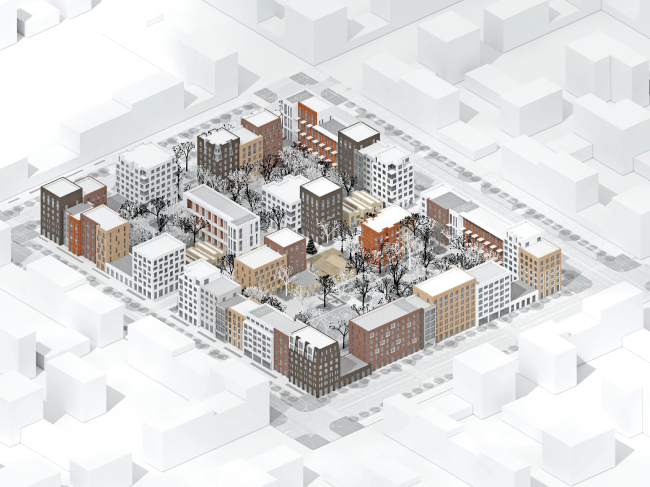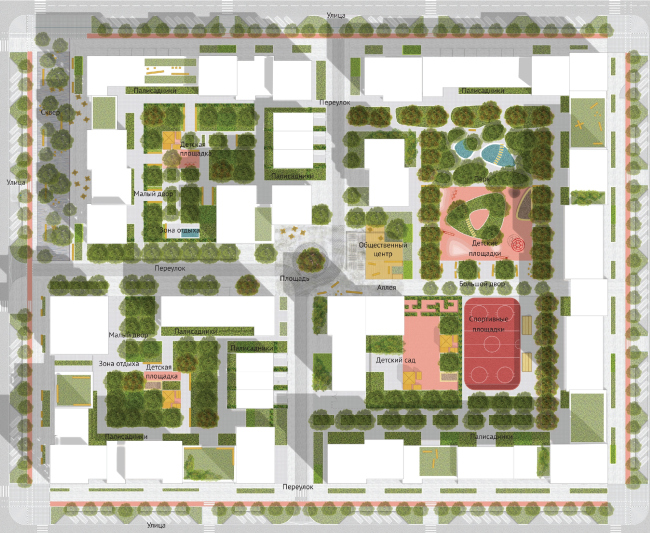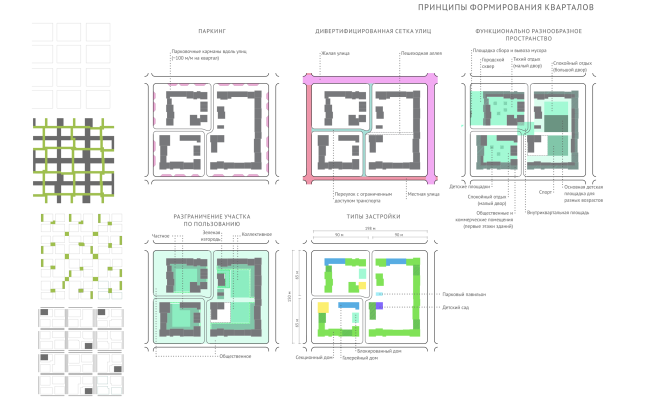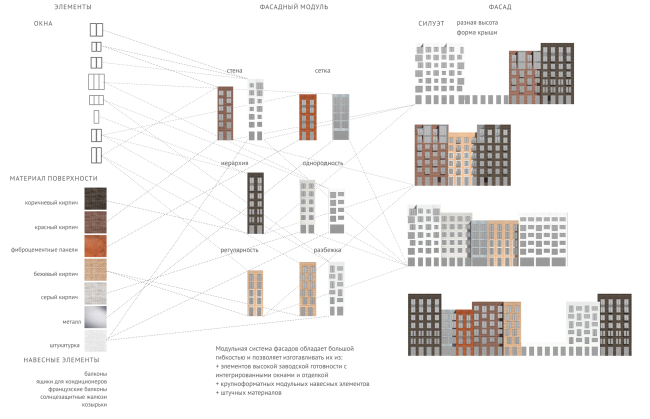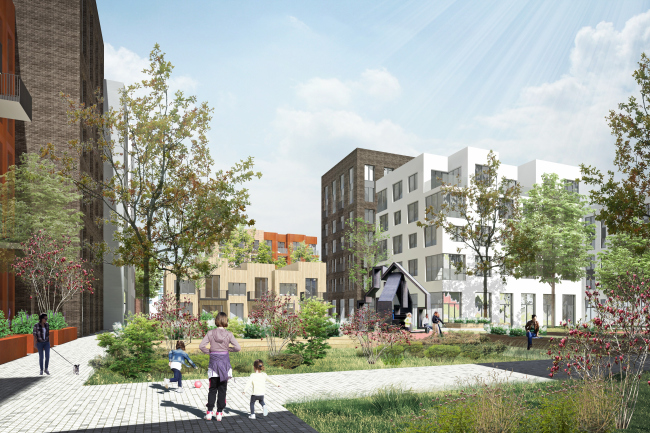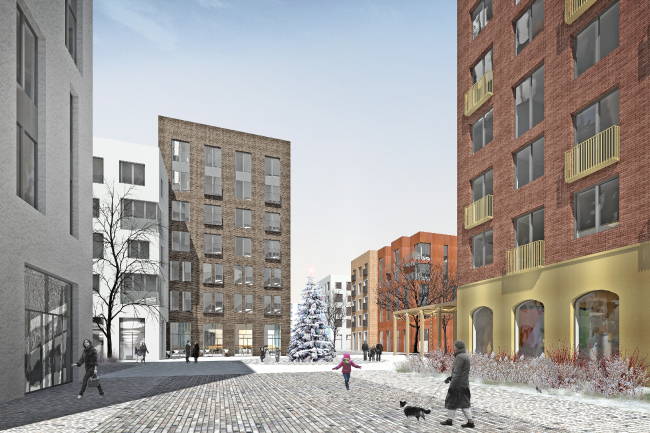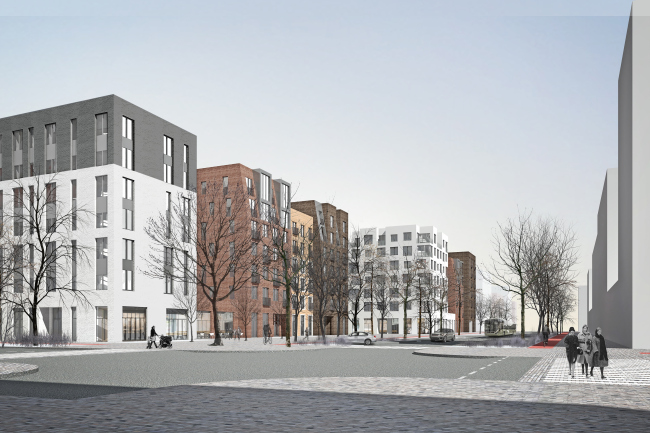|
Published on Archi.ru (https://archi.ru) |
|
| 15.02.2018 | |
|
DNK ag: “To us, this competition became an opportunity to propose an optimum model of a high-quality and diverse living environment” |
|
|
Julia Tarabarina |
|
| Studio: | |
| DNK Architectural Group | |
|
The architects Daniel Lorentz, Natalia Sidorova, and Konstantin Khodnev, whose project got shortlisted to make the top twenty of the competition organized by the Agency for Housing Mortgage Lending for the best mass housing project, share about the meaning of this competition, the perfect populated area, and the conditions necessary for achieving this ideal in a micro-development situation.  Prefab and standardized vs housing standards At first, this idea did not appeal to us at all. From an architect’s point of view, standardized housing is something that cannot be any good by definition because it takes the bread out of his mouth and leaves the architect bereft of a huge chunk of the design and construction market. Generally, we believe that standardized construction shouldn’t be there in the first place – and we are saying this not only based on our professional considerations but also because all geographic regions and contexts are very different, and, besides, the typologies and their requirements are constantly changing. In the perfect world, each project must be individual and must be tailored for its own specific place. The last thing that we want to believe is that the objective of this competition was to get a yield of N new projects in order to spawn new development and construction companies, one of which would copy-paste what they would call “houses by DNK” – in a word, duplicate somebody’s final-making solutions. This would be a terrible thing to happen. But then again, such a grim situation is next to impossible now because our state no longer functions in this way. And at the session devoted to reviewing the results of the first round the judging panel also said that the architects should work more with the context and the building’s location, even though one should admit that this sounded a little bit strange in reference to the “standardized” housing. So, it took us quite a while debating this decision of whether or not to take part in this competition, and what our end game would be. Because, you see, the very term “standard” can mean many different things. Most people associate the term “standardized” with prefabricated houses, and this term bears a negative connotation, too, especially when it is about building on a grand scale – but then again, there are such notions as living standards and the construction quality standards. What we thought about was these latter standards, approaches and principles of a maximally adaptive model of comfortable mass housing. The Strelka Institute is now working on developing the standards for housing construction, and I don’t rule out the possibility that from the organizer’s side this contest was an attempt to test the resulting model, see how it works in some certain “project” reality; to fathom the depth of the problem. To us, this work was interesting specifically in this sense. This is why this contest project is a manifesto for us, a demonstration of how mass housing can be designed – essentially, it all comes down to designing a decent housing project. It was interesting to us to design such a project that we would like ourselves, with a comfortable and diverse living environment. Medium number of floors The medium-rise model seemed to us the best option of all that were on the table, the “happy medium” – we really liked the housing density parameters and the 5-7 floors height restrictions, these are close to optimum ones, and they are capable of creating a comfortable environment on their own: they yield the inside and outside environment or such a good quality that the question of façades is no longer the crucial one. Yes, the façades, of course, always do stand to matter, but here they stop being the one and only thing that the architects have to worry about – the environment does not solely depend on some unique form or material. In addition, the medium-rise version yielded more square footage which was nice from the town-planning standpoint. Currently, the Moscow region is reaching ever higher up, both at its center and at the outskirts – and I don’t think we need to explain the drawbacks of high-density construction in those places where it is there without any apparent reason. In such places, the monstrous construction density destroys the environment, and, ultimately, it destroys people. Of course, we are still interested in designing unique projects but we still cannot turn our blind eye to what’s happening to the mass construction segment – this is also one of the reasons why we decided to take part in this competition. Standardized housing concept for medium-rise construction © DNK Architectural GroupAdaptive city block We believe that diversity is one of the basic principles of a high-quality living environment. We proposed a maximally flexible set of approaches and rules for integrated organization of the environment, modular and internally coherent from a single apartment to the principles of organizing the urban environment. We also proposed an apartment module that is essentially a 6.6 x 6.6 meter cell, and a system of supports with water risers with “wet” zones adjacent to them – this system allows you to come up with a whole range of different apartments, choosing and changing their types depending on the current requirements and situation, on one and the same framework. We also proposed a façade module with a minimum width of two windows, and window modules as well – and you can alter all these things by making large blocks, or, opt for the fine fracturing which would be more appropriate in a historical city. Actually, we proceeded from the “historical city” building principles. Standardized housing concept for medium-rise construction © DNK Architectural GroupAnother important principle is the “recessed” or “sunken in” façades that step back from the red line: in our project, some of the façade line coincides with the red line, and then it makes a step back into the depth of the land site. This will allow the local residents to make little gardens in front of the hallway entrances, and this will bring diversity to the construction front. The single-story lintels between the houses are meant to be occupied by shops and restaurants. First of all, our people don’t like living right above shops and restaurants, but this is not the main reason we did that. The main reason is that by doing this we got more corner apartments, and we got these breaks between the houses that allow you to gaze far and beyond. This “city block” construction technique has got people used to the fact that buildings often stand in a freehand fashion, and we feel we should keep it that way. Of course, at the same time it is just as important to divide the private and the public space. Standardized housing concept for medium-rise construction © DNK Architectural GroupWe proposed a hierarchy of inside yard spaces and their functions. In the middle, we have a square and a community center (the latter was not situated in the residential buildings, they only included the housing stock and a kindergarten), which serves as the “gate” of a mini-promenade and a “major” yard with playgrounds and sports fields. On the other side of the block, there are two private “minor” yards, and all of their elements are small. They can be private, of the residents-only kind, or open to general public, as the case might be. The cafes are situated in the center of the block, next to the community center, as well as on the outside contour, where the city park is situated, with a slight back step from the red line – these are all necessary elements, and in our proposal we gathered them together, but what is really important is the fact that the solutions based on our module can and must be adaptive and diverse. You can compare this to clothes: they can be very different, including price-wise, but they are all made for people, they’ve got sleeves in them, buttons, and pockets, and this is what unites them – but still different people dress differently. We were looking to create a similar housing construction kit that could you could alter within the framework of some certain parameters and get very different solutions, appropriate for different conditions. At some places you can get a mottled and free-plan city block, and somewhere in Petergof, for example, you could do a symmetrical city block, and façades that are resonant with their surroundings. Standardized housing concept for medium-rise construction © DNK Architectural GroupHere is the thing – the more possibilities for adaptation, the more sustainable is your proposal. We proposed modules, out of which you can make lots of combinations. Micro-development In the perfect world, a city block similar to the one that we proposed in our project must be built not as part of some giant construction project but by several developers, in small land plots. The infrastructure – kindergartens, schools, clinics – can be built by the city, and then it can be included into the cost of the land plots. Standardized housing concept for medium-rise construction © DNK Architectural GroupThis idea, of course, remained off-screen because such solutions were not covered by the competition assignment but we think that this was the perfect option, providing maximum diversity – the micro-development. Materials The construction materials can be virtually of any kind. In this particular instance, we based our calculations and estimates on our real projects, proceeding from the idea of solid framework structure. You can use the prefab structures and fill them with breeze blocks, or you can even have prefabricated façade panels – today’s technologies allow you to readjust the production lines rather frequently, and, if there is a demand for it, this is all quite realistic. On the other hand, in those places where you don’t have an easy access to plants and railroads, it is easier and cheaper to build manually upon a monolith framework. Our parameters are equally applicable to wooden building materials, should such need arise. Our concept is very flexible, and it can be easily adapted to new technologies and requirements of the situation. Standardized housing concept for medium-rise construction © DNK Architectural GroupAffordable / mass / normal We don’t like using the term “affordable”, much less “economy class”: this is mass housing, and it must be affordable by definition but this is not an architectural problem, rather, a social and economic one. People must have an opportunity to make enough money to buy themselves normal housing, and then the problem of “affordability” will simply cease to exist. If, however, you lay your main stress on making your housing as cheap as possible, we will soon be spiraling down to building barracks – hey, these things are really inexpensive, if “inexpensive” is the only thing that you want. We are talking about mass housing here. It cannot be expensive – you will not find a single country where it is – but it also does not go below a certain price threshold because there are some certain quality standards. Actually, these are the standards, in accordance with which decent mass housing must be built. It needn’t look spectacular but it needs to be diverse. Later on down the line you will be able to dilute it with some colorful accents and inclusions. Standardized housing concept for medium-rise construction © DNK Architectural GroupSolutions that help you economize in the course of the building’s operation These are very important, and, sadly, few architects pay attention to them now: saving a few extra bucks by investing less in the construction may lead to the fact that a few years later you will have to take the whole building apart and put it back together again, changing the façades and the engineering lines, collecting money from the residents. And here we are speaking not only about energy efficiency or saving the power, although these are also important) because the utility bills keep going up, and soon for many people the rates for power consumption will become a critical factor influencing their decision making when it comes to buying a home. What is important, however, is that the new standard must take into account the successive years of the building’s operation, and the sustainability of its solutions. We, for example, in addition to the thought-out planning structure, provided for rather simple façade designs in order to minimize the risks of something going wrong under poor quality of construction. What were the benefits of working with the competition project? The joy of making it to the top twenty, of course! And the fact that we developed a better understanding of the problems, principles and processes – things that one should pay attention to. The opportunity to organize the knowledge base that we accumulated and turn it into a system, defining the important criteria! Generally, it was great to have an opportunity to make an experiment that would be impossible in real-life construction. Is this project implementable at all in the Russian conditions? Yes, it is quite implementable if there are also some incentives in place; possibly, it will become even more successful if the economic situation gets better, and the appropriate legislation is developed. Of course, looking at the current “traditions” of the mass housing construction, one cannot predict that the situation will change dramatically for the better any time soon. But if you show to the people the advantages of the new solutions, people will want to live like this, and we don’t rule out the possibility that this type of housing will finally become a norm rather than a news break, just the way that it should be. |
|
